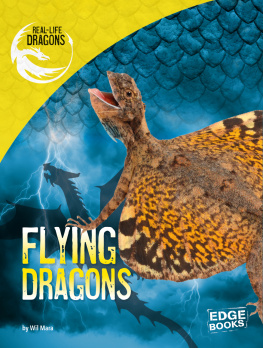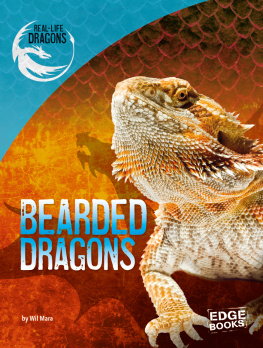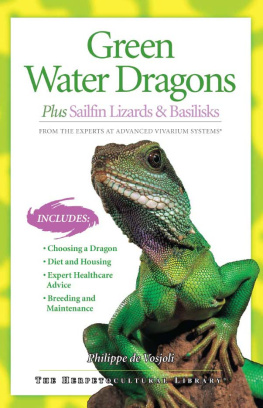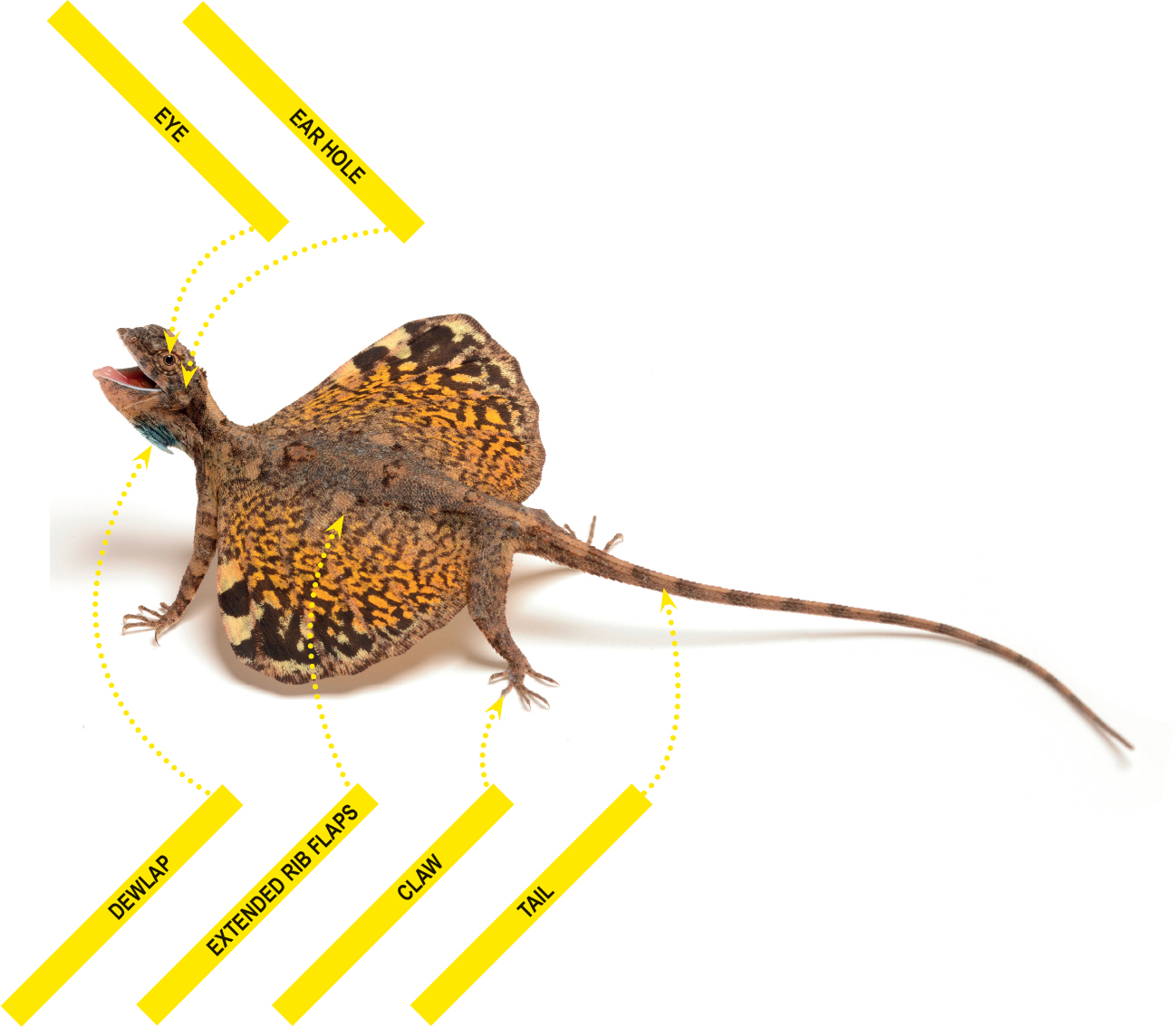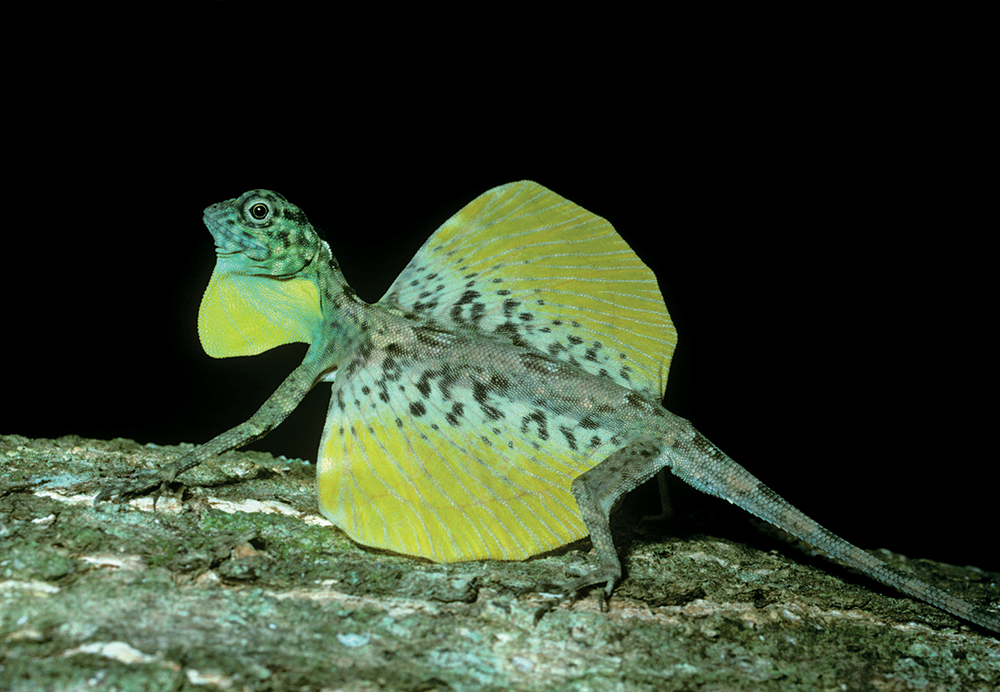FLYING DRAGON FACTS
- COMMON NAME:
- flying dragons
- GENUS NAME:
- Draco (all flying dragons)
- SPECIES:
- about 40 known to scientists
- RANGE:
- the Philippines and Borneo in the east, west across parts of southeastern AsiaChina, Thailand, Myanmar (Burma), Vietnam, and othersand into southern areas of India
- HABITAT:
- mostly tropical rain forest areas, or anywhere with enough trees and leafy cover to provide security
- SIZE:
- rarely over 10 inches (25.4 cm) long (including tail); average is about 7 to 8 in (17.8 to 20.3 cm)
- COLORS:
- dull gray, light brown, or medium green; expandable ribs and dewlap can be bright red, yellow, orange, or green, with darker patterns mixed in
- PREDATORS:
- birds, larger lizards, snakes, people
- LIFESPAN:
- uncertain, but likely around two to four years
GLOSSARY
(KA-muh-flahzh) coloring or covering that makes animals, people, and objects look like their surroundings (KA-nuh-pee) the top layer of the rain forest where the greenery is thick and there is little sunlight (KLAS-uh-fy) to put into a group (KOHLD-BLUHD-id) having a body that needs to get heat from its surroundings (DOO-lap) a brightly colored flap of skin under the neck that can extend outward (in-DAYN-juhrd) at risk of dying out (GEE-nuss) a rank in animal classification that comes after family and before species (HAB-uh-tat) the natural place where a plant or animal lives (in-SEK-tuh-VORE) an animal that eats insects (MATE) to join together to produce young (PRED-uh-tur) an animal that hunts another animal for food (PRAY) an animal hunted by another animal for food (RAYNJ) an area where an animal mostly lives (ri-ZISS-tuhnss) a force that opposes or slows the motion of an object (SPEE-sheez) a group of creatures that are capable of reproducing with one another (tare-uh-TOR-ee-uhl) defending an area of land as ones own
READ MORE
- Rake, Matthew. Scaly, Slippery Creatures. Real-Life Monsters. Minneapolis: Hungry Tomato, 2015.
- Royston, Angela. Reptiles. Animal Classifications. Chicago: Heinemann Raintree, 2015.
- Wilsdon, Christina. Ultimate Reptileopedia: The Most Complete Reptile Reference Ever. Washington, D.C.: National Geographic, 2015.
CRITICAL THINKING USING THE COMMON CORE
- Reread the sidebar on . Explain what makes the flying dragon like a bird and what makes it different from a bird. (Craft and Structure)
- Reread . Why do flying dragons take a break in the middle of the day? (Key Idea and Details)
- Reread the text on pages and study the photographs. How do the photographs help show how the flying dragons body is suited for living among trees? (Integration of Knowledge and Ideas)
INDEX
- ear holes,
- eating,
- eggs,
- eyelids,
- eyes,
- habitats,
- head,
- head bobbing,
- scales,
- size,
- snouts,
- species,
- tails,
- teeth,
- territories,
- threats,
- habitat destruction,
- pet trade,
- tongues,
CHAPTER 1
A DRAGON IN FLIGHT
It is morning on a clear, hot day. A lizard sits atop a small tree. He looks all around. Something catches his eye. His mouth opens. Then he races toward the end of a branch. He leaps into space. Flaps that look like wings spread out from either side of his body. The brightly colored flaps stand out from the dull gray and green of the rest of his body. The lizard hovers in the air like a leaf in the breeze.
A flying dragon glides through the air.
He lands on the branch of another tree. There are five other lizards here. But hes only interested in onea male, just like him. The other four lizards, all females, scurry off. The glider opens his flaps again. The bright colors make for a wild display. The other male decides hes in the wrong place. Now its his turn to jump into the air and soar away.
Its just a typical day for these flying dragons.
The Dragons of Myth
The real-life flying dragon gets its name from the creatures of myth. Fictional dragons are huge, fire-breathing beasts. Their tails are spiked. Their skin is scaly. They often fly through the sky. Some animals in nature look like these dragons from storybooks. The flying dragons scaly skin and ability to glide through the air helped it earn its name.
SO MANY COLORS!
The flying dragon is an interesting lizard. This small animal can reach up to 10 inches (25.4 centimeters) long, from head to tail. But it averages 7 to 8 inches (17.7 to 20.3 cm) long. The tail is at least half of the lizards total length. Its body is very thin. Its head is small and triangular. Its eyes are dark. Its snout is pointed. A brightly colored flap of skin, called a , extends out from under the neck.
A flying dragons dewlap and side flaps are usually brightly colored.
Flying dragons range from a dull gray or brownish tan to shades of green. They may have darker patterns or spots. The truly striking colors are found on the flaps of skin on their sides. These can be bright red, yellow, orange, or green. Sometimes the flaps have dark markings.
To Fly or To Glide?
Flying dragons do not actually fly. Instead they glide. They sail through the air for as long as they can stay afloat. The average distance is about 30 feet (9.1 meters). The flaps of skin are not true wings like those on a bird. They are ribs covered with skin. Flying dragons can spread out and pull in the ribs, but they do not flap them like wings.
WHAT MAKES IT A FLYING DRAGON?
Scientists animals that are alike into groups. Flying dragons are classified as reptiles. All reptiles have scales. The scales are dry and tough. Snakes are also reptiles. But unlike snakes, flying dragons have eyelids and ear holes. Reptiles with eyelids and ear holes, such as the flying dragon, are classified as lizards. Also unlike snakes, most lizards have legs. However, a few kinds of lizards are legless!

